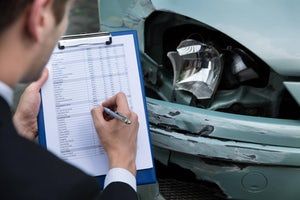
Long after the workday ends, risks continue at construction sites, as fire, theft and water can cause significant property damage and can potentially delay project timelines and impact budgets. The presence of combustible materials, the lack of effective security controls and unstable structural elements can make sites more vulnerable to loss. Buildings under construction or renovation are particularly susceptible because they are unoccupied with portions unprotected from inclement weather. This increased risk, along with daily changes in construction activities and building progress, presents a unique challenge to those in charge of managing site protection.
Fire Risks and Controls
As mentioned above, buildings under construction have a greater potential for significant property damage from fire, especially before fire suppression systems are installed and operational. Secure site access by fencing the area to avoid vandalism and other losses. These guidelines can help reduce the risk of fire on site.
- “Hot work” – cutting, welding and grinding. Many construction fires are caused by the improper use of torches for cutting, soldering, roof work, blazing and welding. Contractors should develop and enforce a formal, written, hot-work permit system with all trades and subcontractors based on NFPA 241, Standard for Safeguarding Construction, Alteration, and Demolition Operations.
- Smoking. Careless smoking is a leading cause of fires. To reduce the chance of fire, smoking should be prohibited inside any building, outside in the vicinity of combustible materials and fuel storage, and strictly enforced. ”No Smoking” signs should be posted at all points of entry. If smoking is allowed, it should only be permitted in designated areas.
- Temporary heating equipment. Depending on weather conditions, temporary heat (propane, kerosene or electric) may be used on job sites. If this equipment is not kept clear of combustibles, set up incorrectly or not functioning properly, it can cause a fire. Ensure all heating equipment is listed and approved for its intended use, placing temporary heaters only on non-combustible flooring or platforms and keeping areas around space heaters clear of combustibles.
- Temporary electrical writing and temporary lighting. Many fires are started by improperly installed or maintained temporary electrical systems. Temporary electrical wiring and equipment for light, heat or power purposes should be installed in accordance with the requirements of the National Fire Protection Association (NFPA) 70® National Electrical Code and inspected regularly by a qualified electrician.
- Fire suppression systems. Permanent fire suppression systems are often not in place or operational on construction sites. It is critical that fire protection systems be installed early and plans developed to provide temporary protection during the course of the project.
- Fire extinguishers. Fire extinguishers can be the first line of defense for combating a fire on a construction site. Mount fire extinguishers suitable for the conditions and hazards in conspicuous positions, on each floor at each usable stairway and train staff in their use.
Good housekeeping. Poor housekeeping practices contribute to fire hazards on many construction sites. Waste material and rubbish should not be stored or allowed to accumulate within buildings or the immediate vicinity, and should be removed from the premises on a daily basis. Keep dumpsters a safe distance from structures.
Water Damage Risks and Controls
Damage caused by water, whether it is from a pipe leak, weather event or act of vandalism, has become the most common cause of loss on building construction projects. Conduct a job site-specific assessment to identify all the possible sources of water, and develop a water damage prevention plan.
- Prevention. The best way to avoid loss from water damage is to prevent unwanted water from entering the building. Residential buildings, especially high-rises, present a great risk for water issues because they include more plumbing and bathrooms, making them predisposed to an increase in water damage losses without the proper controls. Potential sources of unwanted water include temporary roofs, balconies, domestic water service, HVAC and fire suppression piping systems. Follow construction specifications, quality control testing and conduct periodic inspections as part of planning to prevent water damage.
- Detection. Early detection of uncontrolled water inside a building can limit the amount of damage should a leak occur. In addition to instructing workers to report potential leaks to site management, electronic flow/leak detection systems or security guard services can aid in early detection and response.
Response. A water damage response plan, including equipment, should be readily available to identify and arm resources with a swift-response guide to help address the water issue before it spreads.
Theft, Vandalism & Unauthorized Entry
Construction sites are prime targets for theft, vandalism and other unauthorized entry, which can lead to the loss of or damage to work in progress, equipment and materials on the site. Contractors and developers can address this exposure by putting a crime/theft prevention plan in place. A crime/theft prevention plan starts with understanding the potential for crime (theft, burglary, arson and vandalism) in the area. This review will assist in the development of the various layers of theft prevention needed to secure a site.
- Physical barriers. The front line of defense for a construction site is establishing effective physical barriers and access control to prevent trespassers from accessing the site. This can include full perimeter fencing, locked access gates, interior and exterior lighting and warning signs.
- Electronic surveillance systems. Continuously monitored motion-activated detection systems, when installed properly, can help to ward off intruders and prevent losses. In addition to the building under construction, you should monitor structures such as office trailers and materials storage areas and containers. Other types of sensors and alarms can be added to many systems such as temperature, water flow, glass break and electrical service.
- Security guard service. A qualified and insured security guard service should be used be on construction sites to provide an on-site presence during non-working hours, particularly in high crime areas or where values warrant. An effective security service should document periodic rounds of the site, monitor all access points and conditions with clear response and notification procedures to local authorities and site management.
- Project materials management. Material and equipment is often delivered to construction projects well before the building is even closed in and weather-tight, making it an easy target for thieves because it can be quickly converted to cash from an unsuspecting buyer. Plan for just-in-time delivery of materials if possible, and store them in a secure location to reduce the risk of theft.
Original article: https://www.travelers.com/reso...












Discussion
There are no comments yet.